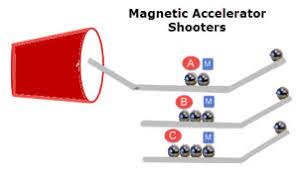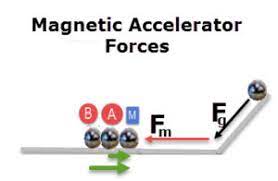 by Janice VanCleave
by Janice VanCleave
I love the magnetic accelerator. In fact, I met friends at a restaurant yesterday and took the accelerator with me. We had a lot of fun predicting what would happen and testing our predictions. No formal steps….just making cool guesses and then discovering whether we were correct.
Yes! The steel ball shot off the end of the track and hit the floor a couple of times, but that just added to the excitement. It’s a small town and few are surprised that the eccentric science author is experimenting at the restaurant–again!
A parent came in with her daughter, a second grader. With the mother’s permission I invited the child to sit with us. The girl had sinus problems and didn’t feel well. She was a bit sluggish and her eyes looked dull, as one would expect. When I asked the child if she wanted to do some science experiments, her dull eyes brightened. She had not been present during the previous testing of the accelerator, but she was immediately interested.
I started with the steel balls and kept the magnetic ball in a separate container. Before handing the child one of the balls, I asked whether she knew what gravity is. She said no. I discovered that I had asked the wrong question. Children know a lot about science, but they have to be asked the right questions.
Our dialog about gravity went something like this:
- If you hold a ball as high as possible and turn it loose, what happens to the ball? It falls down.
- What makes the ball fall down? Hesitantly the child said, “gravity.”
YES! That is right! Gravity makes things fall down.
With a bit of guidance, the child had been led to give the correct answer. Now it was time to seal the deal, so to speak. I wanted to continue to encourage her to identify motion due to gravity. I gave her one of the steel balls and asked her to place it at the top of the track and hold it there.
I placed a plastic cup over the opposite end of the track and told her that it was there just in case the ball rolled off the end. This gave us something to discuss and make a prediction about. First we talked about what would happen to the ball when she released it. I asked whether the ball would fly upward, and her look said volumes. It was the look that indicated that everyone knows better than that. We continued to discuss the possible motion of the ball and decided that it would move down the track because of –yes, gravity: the force that pulls things down. Now I was ready to introduce discovery-type questions.
Question: When you release the steel ball, how far do you think the ball will roll on the track?
To make sure the child understood the question, I asked other questions, such as, “Do you think the ball will roll off the end of the track or maybe the ball will stop at the bottom, indicating at the 50 cm mark on the meter stick?”
The child had not performed nor seen the experiment performed, but even a second grader has knowledge as well as experience about the motion of things. The problem often is that children don’t really understand what the adult wants them to do. But when there is communication, even young kids can give good predictions founded on their own knowledge (not the knowledge of the adult).
Prediction: I didn’t use the term prediction. Instead, I called it a Cool Guess. I later told her, scientists called Cool Guesses a hypothesis. This was a bit of a tongue twister for her, but she gave it a good try and eventually said it well. Note that she forgot most of the word before she left, but with repetition she would soon own this new word and would know how to use it.
Experiment Results: The ball rolls down the incline and up the opposite incline. If the table is level the ball will almost reach the top before stopping and rolling back down. The ball continues to roll back and forth, going shorter distances each time.
Extension: As the ball rolls back and forth on the curved track I ask whether the ball was moving faster or slower each time. At first she said faster but it was quickly evident that the ball wasn’t going as high on the inclines and she changed her answer to “slower.” I had given her time to observe and change her mind. Too often in a classroom others give the right answer and the child may feel embarrassed for giving the wrong answer. I’ve been thinking of ways to prevent this, and one way for this example would have been for me to have first asked the child to observe the movement. In other words, I would give her time to make the observation that the ball was slowing down before asking her the question. If you have other suggestions, please share them.
Enrichment Ideas for Older Elementary
Energy-Force-Acceleration
At the top of the incline the ball has potential energy (PE) because of its height. The higher the end of the track is raised, the more potential energy the ball has. When the ball is released the force of gravity pulls the ball down the incline. The ball rolls faster and faster until it reaches the bottom of the track. Things that change their speed are said to be accelerating, thus the ball accelerates down the track because of the force of gravity.
Kinetic energy (KE) is the energy of a moving object. Too often KE is thought to be the energy that causes motion; instead it is the energy of an object in motion. The faster the motion, the more KE. Thus, at the bottom of the track, the ball has its greatest KE and no PE. This means the PE is transformed into KE as the ball moves down the inclined track.
At the bottom of the track the ball moves up the incline opposite the one it just rolled down. Gravity continues to pull the ball downward. Thus, the ball decelerates, meaning its speed gets slower and slower until it stops. Without friction, the stopping and starting height of the ball would be the same. Friction is the force that resists the movement of two surfaces moving against each other. Friction slows the motion of the steel ball rolling on the track.
More Fun!
I placed two steel balls in the center of the track and asked the child to release a third ball at the top of the track, as before. She was surprised that the ball on the far end moved forward.
My objective was for her to make guesses, experiment, and make observations, so I lined up three balls. Her guess was that two balls would move forward and two would move backwards. I was impressed with her answer. She was again surprised that only the end ball moved forward. Without getting into details, we briefly discussed transferring energy.
Let the Magic Begin
The magnetic ball is the magic. I like that it looks like the other steel balls, but it also makes it difficult to identify when they are all together. I keep the magnetic ball in a small bottle with a lid and have it labeled–Magic Sphere.
I held the “Magic Ball” in my hand and told the child that I was going to give the ball its magic instructions. The child rolled her eyes as I whispered into my hand, then, with much care, so that the balls did not clang together, I lined up three balls on the track. I was careful to place the Magic (magnetic) ball first in the line so that it would be the first ball hit. I held the plastic cup in place as the child prepared to release her steel ball from the top of the track.
IMPORTANT: The order of the balls matters. The magnetic ball MUST be first in line. In other words, the ball rolling down the incline must hit the magnetic ball first.
SURPRISE RESULTS! The end ball shot forward and would have been propelled across the room had I not held the cup tightly in place.
I asked the child if she believed the ball was magic. Without a word she tried to pick up the “so called” magic ball to examine it and found the entire chain of balls stuck together. The child grinned and said, “The ball isn’t magic, it’s a magnet.”
I had not introduced the term magnet, but this second grader was not only familiar with the term but knew how a magnet behaved. Did she understand why the presence of the magnet caused the ball to shoot forward at a much faster speed? No, and there was no reason to explain this to her.
SAFETY: Since I was controlling the direction of the moving balls, the child was able to safely experiment without goggles. In a classroom, I suggest that students wear goggles if they are working in groups.
Enrichment Ideas for Older Elementary
Since the steel ball shoots out quickly, I suggest that you demonstrate this for the class. You want the students to be surprised, yet you want them to be prepared.
Safety: Safety goggles are a must for this investigation.
What to Do!
Provide a sketch of the diagram shown here. Question: Which of the steel balls will be shot forward with the greatest initial velocity, A, B, or C?
Explain that the magnetic ball, M, must be the first ball in the line so that it is the first ball hit by ball rolling down the slope.
Ask students to give an explanation of why there is a difference between the initial velocities of the shooter balls.
So What Happens and Why?
The force of gravity pulls the ball down the slope, then the magnetic force of attraction toward the magnetic ball increases the rolling ball’s speed. The KE of this ball is the same for each of the investigations. Thus, the amount of KE transferred from one ball to the next is basically the same. There is always a loss of energy due to friction.
 While less KE is transferred to Ball C because there is some loss with each transfer between the balls, Ball C is still the fastest shooter. This is because there is less magnetic attraction between Ball C and the magnetic ball. Ball A receives the most KE of the three end balls, but it is the slowest because the magnetic attraction between this ball and the Magnetic Ball is the strongest.
While less KE is transferred to Ball C because there is some loss with each transfer between the balls, Ball C is still the fastest shooter. This is because there is less magnetic attraction between Ball C and the magnetic ball. Ball A receives the most KE of the three end balls, but it is the slowest because the magnetic attraction between this ball and the Magnetic Ball is the strongest.
